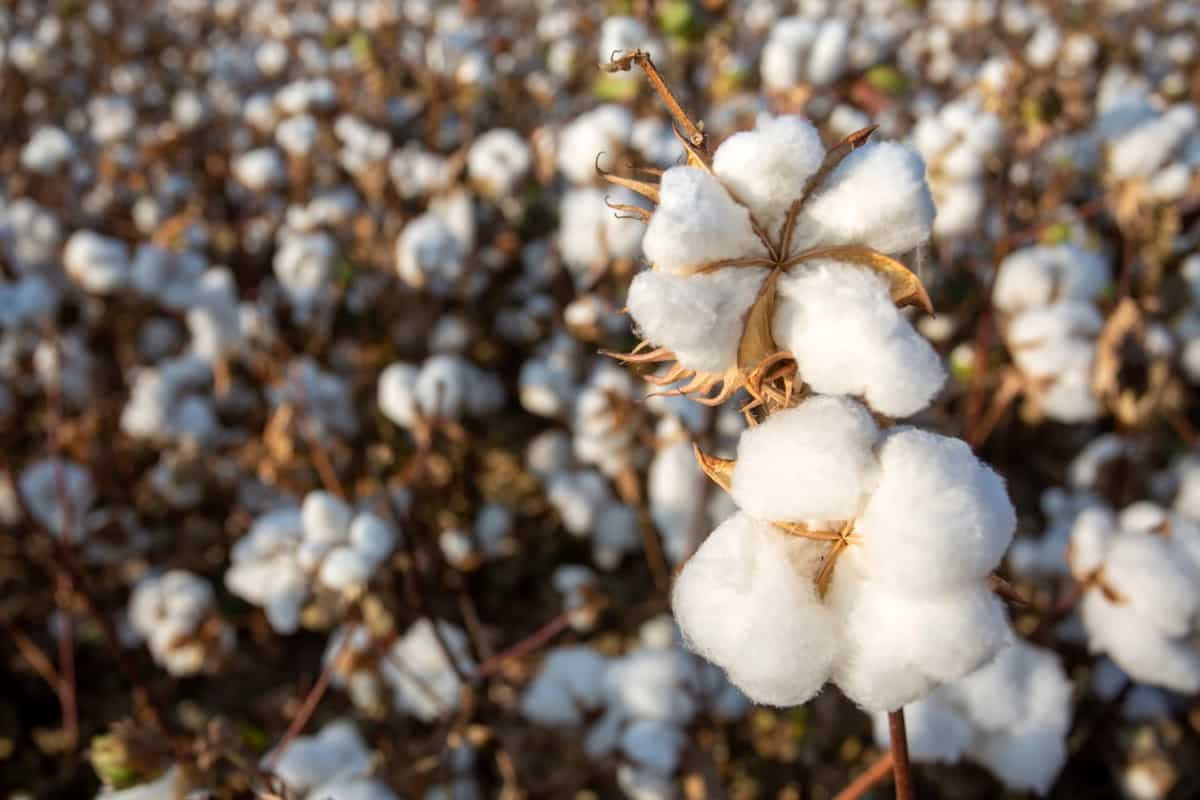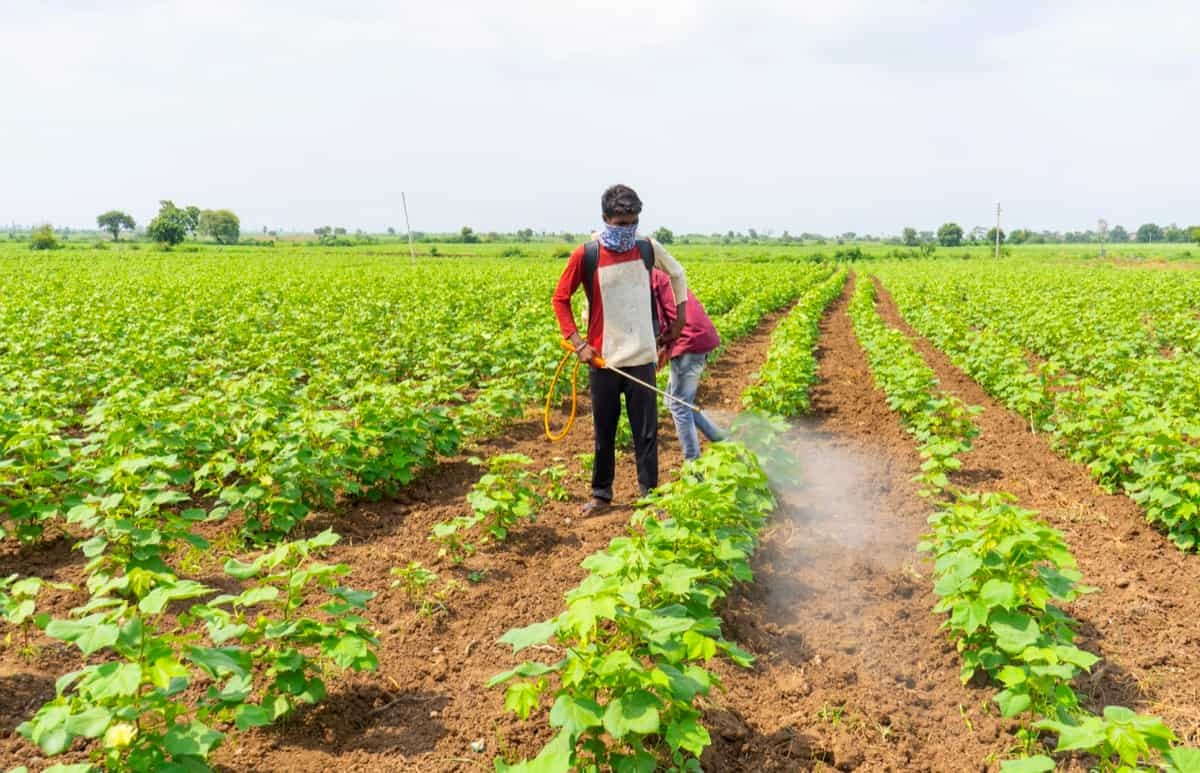Welcome to our blog on Common Cotton plant diseases and control! This article will explore the causal organisms, damage symptoms, spread, treatment options, prevention strategies, and management techniques for these diseases. Join us as we provide accurate information on protecting your cotton plants and ensuring a healthy yield. Let’s dive in!

Major and Common Cotton Damaging Diseases
Cotton is a perennial shrub in the Malvaceae family, consisting of four species: Gossypium hirsutum, Gossypium barbadense, Gossypium arboreum, and Gossypium herbaceum. G. hirsutum dominates global cotton production, comprising about 90% of it. The plant features spirally arranged leaves with lobes, single flowers, and oval seed capsules called “bolls.” These bolls split open to expose white cotton fibers and seeds. Cotton is typically cultivated as an annual plant, reaching heights of 1-1.5 m, and its origin is uncertain but spans regions from Mexico to Australia.
List of Ten Major and Common Diseases of Cotton
- Angular Leaf Spot (Black Arm Disease): Causes black spots on leaves, leading to defoliation and reduced yield.
- Vascular Wilt Disease: Blocks water movement in the plant, resulting in wilting, yellowing, and plant death.
- Grey Mildew (Dahiya Disease): Fungal infection causing gray patches on leaves, reducing photosynthesis and boll development.
- Anthracnose Disease: Fungus attacks stems, leaves, and bolls, causing dark lesions and premature boll shedding.
- Root Rot Disease: Pathogens attack cotton roots, causing rot, stunted growth, and nutrient deficiency.
- Boll Rot Disease: Fungal infection affecting bolls, causing rot, premature opening, and reduced fiber quality.
- Leaf Spot (Blight Disease): Fungal or bacterial infection causing spots on leaves, leading to defoliation and yield loss.
- Reddening (Lalya Disease): Virus-induced chlorosis, resulting in leaf reddening, stunted growth, and yield reduction.
- 2,4-D Injury Disease: Herbicide damage causing leaf curling, growth abnormalities, and yield decline.
- Tobacco Streak Virus Disease: Viral infection causing leaf mosaic, boll deformation, and yield reduction.
Angular Leaf Spot or Black Arm Disease Control in Cotton
- Causal Organism: Xanthomonas axonopodis pv. malvacearum (Smith) Vauterin.
- Symptoms: Small water-soaked spots on cotyledons and leaves, turning angular and brown to black. Stem, petioles, and branches develop elongated dark lesions. Bolls may have sunken black lesions, leading to premature falling-off and lint discoloration.
- Spread: Through infected leaves, bolls, twigs, water, and wind.
- Treatment: Field sanitation, seed delinting, streptomycin sulfate or Agrimycin seed soaking, and streptomycin sulfate + Copper oxychloride spray.
Vascular Wilt Disease Control in Cotton
- Causal Organism: Fusarium oxysporum f. sp. vasinfectum (Atk.) Snyder and Hansen.
- Symptoms: Yellowing and death of cotyledons and leaves, drooping of leaves and shoots, yellowing, browning, and plant death.
- Spread: Through soil-borne inoculums.
- Treatment: Field sanitation, crop rotation, mix cropping, and use of resistant varieties.
Grey Mildew or Dahiya Disease Control in Cotton
- Causal Organism: Imperfect stage: Ramularia areola Atk. Perfect stage: Mycosphaerella areola.
- Symptoms: Pale, translucent spots on older leaves, restricted by veinlets. Leaves turn yellowish brown and fall prematurely.
- Spread: Airborne conidia.
- Treatment: Destruction of infected plant debris, dusting with sulfur or propiconazole spray.
In case you missed it: Tobacco Streak Virus Management in Cotton: Disease Symptoms, Treatment, Chemical, Biological, Natural, and Organic Control

Anthracnose Disease Control in Cotton
- Causal Organism: Imperfect Stage: Colletotrichum gossypii Southw. Colletotrichum capsici
- Perfect Stage: Glomerella gossypii (Southw) Edgerton.
- Symptoms: Reddish circular spots on cotyledons and leaves. Stem splitting and boll infection with water-soaked spots turning black. Stained, hard, and compact lint.
- Spread: Infected seeds, plant debris, and wind-disseminated conidia.
- Treatment: Seed treatment, copper oxychloride, or Zineb spray.
Root Rot Disease Control in Cotton
- Causal Organism: Sterile Stage: Rhizoctonia bataticola (Taub.) Butl. Imperfect Stage: Macrophomina phaseolina (Tassi) Goid.
- Symptoms: Browning and decay of cotyledons and collar region, decaying fibrous roots, and rotting of bark. Easy pulling out of affected plants.
- Spread Crop residue with sclerotia as the primary source of infection.
- Treatment and Management: Seed treatment, soil mulching, mixed cropping, and disinfection.
Boll Rot Disease Control in Cotton
- Boll Rot Disease is a complex disease caused by several fungal pathogens such as Fusarium moniliforme, Colletotrichum capsici, Aspergillus flavus, A. niger, Rhizopus nigricans, Nematospora nagpuri, and Botryodiplodia sp.
- Symptoms: Initially, small brown or black dots appear on the bolls, which enlarge and cause the rotting of seeds and lint. The bolls do not burst open and fall prematurely. The disease can be spread through infected bolls in the soil and insect-mediated transmission.
- Treatment and Management: Management includes maintaining optimum spacing, balanced fertilizer application, and fungicidal sprays.
Leaf Spot or Blight Disease Control in Cotton
- Leaf Spot or Blight Disease is caused by the causal organism Alternaria macrospora Zimm. The disease can occur in all stages of cotton plant growth but is more severe when plants are 45-60 days old.
- Symptoms: Symptoms include small, pale to brown, irregular, or round spots on the leaves with central lesions and concentric rings. The affected leaves may become brittle and fall off. The pathogen primarily spreads through irrigation water; secondary spread occurs through airborne conidia.
- Treatment and Management: Management involves removing and destroying infected plant residues and applying fungicidal sprays.
Reddening or Lalya Disease Control in Cotton
- Reddening or Lalya Disease affects American and Egyptian cotton varieties.
- Symptoms: The leaves of affected plants turn yellow or red, starting from the margins and extending inwards. In severe cases, the entire leaf may be involved. The affected leaves roll downwards, dry up, and shed prematurely. The disease is favored by high humidity, cloudy days, low temperature, and magnesium-deficient soil.
- Treatment and Management: Management strategies include improving soil conditions by applying organic matter or nitrogenous manures, providing windbreaks, and taking measures to prevent temperature drops below 34°C.
2, 4-D Injury Disease Control in Cotton
- 2, 4-D Injury Disease is caused by the herbicide 2,4-D, used for weed control but can harm sensitive crops like cotton.
- Symptoms: Symptoms include narrow and deeply lobed leaves, scorching, rolling, and puckering of leaves, disruption of phloem tissues, wilted appearance, alteration of nucleic acid and protein metabolism, blocking of gaseous exchange, and malformation of the crop. The severity of the damage depends on the concentration of 2,4-D and can be observed within 2-10 days.
- Treatment and Management: Management options are limited, but urea spray may provide some recovery if the damage is in the early stage.
Tobacco Streak Virus Disease Control in Cotton
- Cotton streak disease, caused by Tobacco Streak Virus (TSV), was newly recognized in India.
- Symptoms include chlorotic and necrotic spots, leaf distortion, and generalized leaf and stem necrosis. Thrips transmit the virus and can infect other hosts like sunflowers, groundnut, and soybean. High thrips population is associated with virus-infected fields. Detection of the virus is done through specific antibody reactions in ELISA tests.
- Treatment and Management: Management strategies for the disease are limited, and prevention measures mainly focus on controlling thrips populations through insecticide application.
In case you missed it: Alterneria Leaf Blight Management in Cotton: Disease Symptoms, Treatment, Chemical, Biological, Natural, and Organic Control

Conclusion
Some major diseases affecting cotton plants include Angular Leaf Spot or Black Arm Disease, Vascular Wilt Disease, Grey Mildew or Dahiya Disease, Anthracnose Disease, Root Rot Disease, Boll Rot Disease, Leaf Spot or Blight Disease, Reddening or Lalya Disease, 2, 4-D Injury Disease, and Tobacco Streak Virus Disease. Various organisms cause these diseases and exhibit specific symptoms, modes of spread, and management approaches.
- Deworming Schedule for Dogs/Puppies: A Beginners Guide
- How to Prevent and Control Parasites in Goats
- Beneficial Insects in Pest Management
- Natural Solutions for Pest Control in Flower Gardens
- Types of Fungicides Used in Agriculture
- Common Issues in the Fruit Development Stage of Pomegranate Farming
- Fruit Development Issues in Papaya: Easy Solutions and Treatment
- Soil-Borne Diseases and How to Protect Your Plants
- Practices to Prevent Disease Spread in the Garden